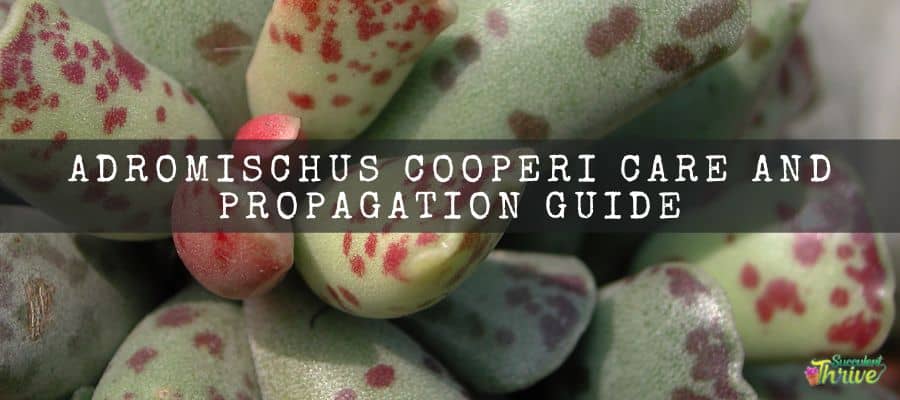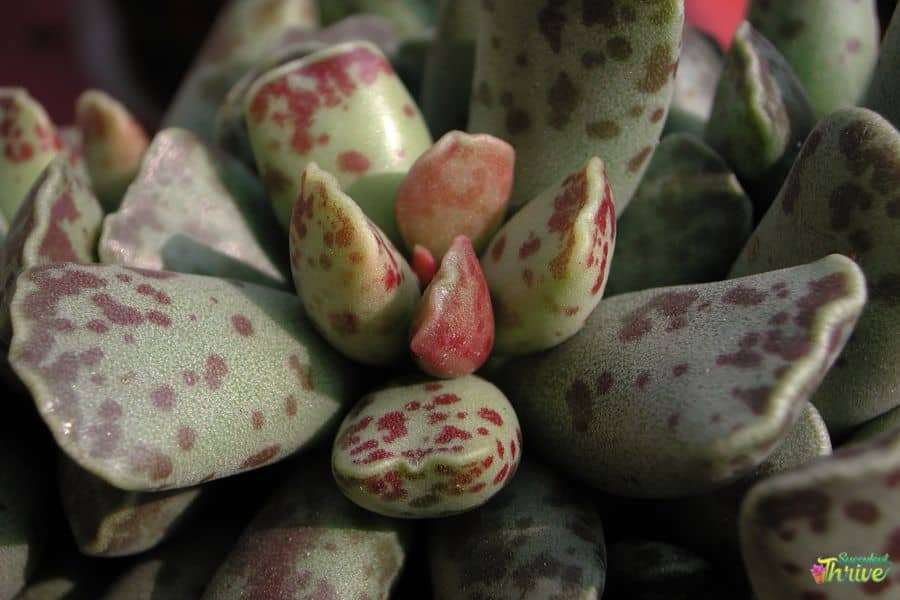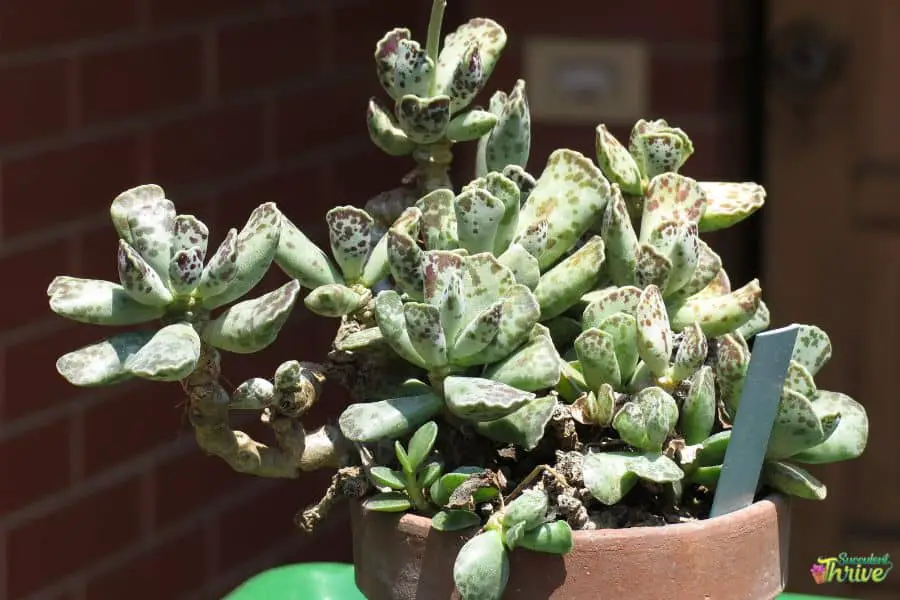If you’re looking for an ornamental succulent that requires little upkeep, consider Adromischus cooperi plants. They would be a great addition to your succulent collection.
The reddish speckles would make these plants look great in any home garden. Looking after these plants is not complicated at all. These plants also go by the common name “Plover Eggs.”
So, in this article, I will be describing all the basic care you need to practice when looking after these plants. Aside from that, I’ll show you how to propagate these plants and create new ones. So let’s get started reading the article to increase your knowledge of growing these plants.

One look care guide
| Botanical Name | Adromischus cooperi |
| Common Name | Plover Eggs plant |
| Plant Type | Succulent |
| Mature Size | 10 cm ( 4 inches ) in height |
| Sun Exposure | Full sunlight to partial shade |
| Soil Type | Well draining |
| Soil pH | Neutral |
| Bloom Time | Spring |
| Flower Color | Pink, purple and in white |
| Hardiness Zones | 9b-11b ( -3.9 degrees Celsius ) 25 degrees Fahrenheit |
| Native Area | South Africa |
| toxicity | Toxic |
| Average price | 7 USD |
How do I identify Adromischus cooperi?
Adromischus cooperi plants are dwarf and perennial succulents. The leaf ends are curved in shape. Furthermore, the color of the leaves are pale green in color. Moreover, once you expose the plants to ample sunlight, you may spot them developing reddish speckles on the leaves.
In addition to these characteristics, Adromischus cooperi plants come up with flowers which are tubular shape. You could spot them forming in pink, purple, and white as well. They are small, yet those flower blossoms would add so much glamor to the entire plant.
Size of the plant
When they grow to their best potential, Adromischus cooperi will attain a maximum height of 10 cm ( 4 inches ).
Growth rate
Adromischus cooperi plants are slow growing plants
Adromischus cooperi care
Light Requirement
They require full sunlight for about 8 hours daily. That said, you need to refrain from exposing these plants to direct sunlight during midday as it would be too intense for the Adromischus cooperi to take in. Consider that you exposed the plants for direct sunlight mistakenly then chances are that it would make the plants’ leaves wrinkled and make them dry. Ultimately, it may even result in fatal outcomes for the plants too.
If you think of growing these plants as houseplants, you need to locate them near a bright, sunny window edge, as it would be the most appropriate place to locate them. However, I suggest you bring the plants outdoors during the summer, as this would allow the plants to gain more sunlight. Furthermore, it would be better if you could rotate the plants on a weekly basis, as then the plants can absorb sunlight evenly. If your Adromischus cooperi plants are lacking sufficient sunlight, you need to consider growing them under artificial lights. Artificial lights would provide the required light and the required heat as well.
Temperature and humidity
If the outdoor temperature is above 24 degrees Fahrenheit, you can grow these plants outdoors. Avoid exposing these plants to temperatures below 5 degrees Fahrenheit. Adromischus cooperi can tolerate frost for a brief time. Generally speaking, Adromischus cooperi would grow well at a temperature above 20 degrees Celsius. During winter, a temperature range between 50 degrees Fahrenheit and 59 degrees Fahrenheit ( 10 degrees Celsius and 15 degrees Celsius) would be optimal for these plants.
Is it cold-hardy?
Adromischus cooperi plants are tolerant of mild frost, but not for too long. Generally speaking, Adromischus cooperi plants do not handle the cold well.
Hardiness zone
Plants of Adromischus cooperi thrive in USDA hardiness zones 9b-11b (-3.9 degrees Celsius) or 25 degrees Fahrenheit.
Watering Requirement
Watering the Adromischus cooperi plants is a delicate factor. You need to limit watering to twice a month. In contrast, you can water them as often as once every week or once every ten days during spring and summer. When you water, you need to ensure that you soak the plant’s soil well.
I recommend watering the plants from the right above. It should ideally keep the soil moistened for some time, and then it should dry after that. Do not ever water them if the soil is still moist.
Always bear in mind that over-watering could be fatal to these plants and always try to water them moderately. If you end up supplying too much water, it would contribute to the health deterioration of the plants, which would ultimately lead to fatal diseases such as root rot. On another note, if you water them less, you can revive the plants easily with one or two watering sessions, whereas overwatering would lead to much more adverse impacts on the plants.

Soil Requirement Type / pH
Adromischus cooperi plants opt to grow in a substrate which has a well-draining facility as well as good aeration. It is important that your chosen soil mix is well draining as only then it would drain the excess. The remaining water in the soil mix I suppose the best and most convenient way is to use the commercially made succulent or cactus soil mix to grow these plants.
In addition to that, you can use a regular soil mix and amend it with substances such as pumice and perlite, as those substances would increase the drainage facility of the soil mix. The most appropriate soil mix would be a mix of dry leaves, peat and some coarse sand.
Pot size Potting and Repotting
Adromischus cooperi opts to grow in a terracotta or clay pot as those materials are helpful for the healthy growth of the Adromischus cooperi plants. They have a high porosity, and it would allow the excess water to evaporate rapidly in those materials. Besides, those pots should have sufficient draining holes as well.
Repotting should be done only once every two years. These are slow-growing plants, and you need to avoid repotting the plants quite often. Ideally, you need to repot them only if they outgrow the pots. Moreover, if you have freshly purchased the plants, you need to first repot the plants and then start growing them. Having said that, you need to ensure that you repot the plants periodically as it is important to ascertain the healthy growth of these plants.
Where to Plant
Adromischus cooperi has a prime requirement when it comes to light. So, I plant them in an outdoor garden, it has to be a place where the plants can absorb full sunlight when the conditions are not too intense and partial shade when it is too intense. I recommend you plant them outdoors if you struggle to provide adequate sunlight.
Adromischus cooperi would require warm temperatures, and if you live in USDA hardiness zone 9b–11b, you can grow them as outdoor plants. However, if the forecast is such that there will be much colder conditions, you can place them indoors given that you fulfill the sunlight requirements of the Adromischus cooperi plants.
Fertilizer and time of year
I feed the Adromischus cooperi plants twice a year. The easiest way is to feed them with a fertilizer that is specially designed for succulents. You can purchase them online as well as from your closest garden store.
Flower
You could spot the Adromischus cooperi plants bearing flowers in pink, purple, and white as well. They would be small and tubular in shape. They would produce flowers in spring.
Dormancy
Adromischus cooperi plants are winter dormant plants.
Toxicity
Adromischus cooperi plants may cause a toxic reaction in pets and children. It would make you vomit and feel dizzy as well.
Common bugs and illnesses
Adromischus cooperi plants are resistant to the pests’ attacks and to diseases as well. Having said that, would pests such as mealybugs and weevils create problems for these plants? If you ever have to deal with these conditions, you may make use of isopropyl alcohol and neem oil to treat them. Besides all these, if you end up over watering the Adromischus cooperi plants, it will result in rot.
Special Care tips
Adromischus cooperi plants are low-maintenance plants. However, I suggest you clean the succulent leaves with a dampened cloth so that it removes all the dirt in the plants. Furthermore, Adromischus cooperi plants may tend to grow their leaves at the slightest touch. As a result, take great care when interacting with the plants.

How to propagate Adromischus cooperi
Adromischus cooperi plants could be propagated by using their leaves, offsets, and cuttings as well. First of all, it is noteworthy that you should conduct repotting in spring and in summer. Adromischus cooperi plants are dormant during winter, so do their roots too. As such, it would be risky to propagate the plants during winter.
If you wish to use the leaf cutting propagation method, you need to first arrange a pot that has an appropriate soil mix. Next, take a disinfected sharp knife and snip off a healthy looking leaf. Next, dry the leaf cuttings for one or two days and then transplant them into an appropriate soil mix. Make sure that you place the cuttings in an upward manner. Keep in mind that only the edge of the cut should be attached to the soil. If the leaf got in contact with the moistened soil, it would lead to rot.
Once you complete all these steps, you need to leave the specimen in a brightly lit place where it can gain indirect sunlight. They can also survive in unnatural sunlight too. However, do not expose them to extreme temperature and humidity fluctuations as this is harmful to their health. You may water them when their soil is dry. Don’t over supply them with water, as it would not give you the desired results of the propagation process.
Besides the leaf cutting propagation method, you can propagate these plants by offsets as well. Adromischus cooperi plants develop offsets, and all you need to do is simply separate the offsets from the mother plants by using disinfected tools. Next, dry them for a few days and plant them in a potting medium that has excellent drainage.
Adromischus cooperi benefits
Adromischus cooperi plants are adorably cute and would glimmer up your garden to a whole new level. Actually, they would offer nectar to pollinators as well. Additionally, you have the option of planting them in separate pots.
Conclusion
To recap what we covered in this article, Adromischus cooperi plants are adorable plants which would amaze anybody with their beauty. You will feel accomplished once you spot them flourishing and when they emerge with flowers too.
Read Next : 11 Adorable Small Cactus Types For Your Desk
